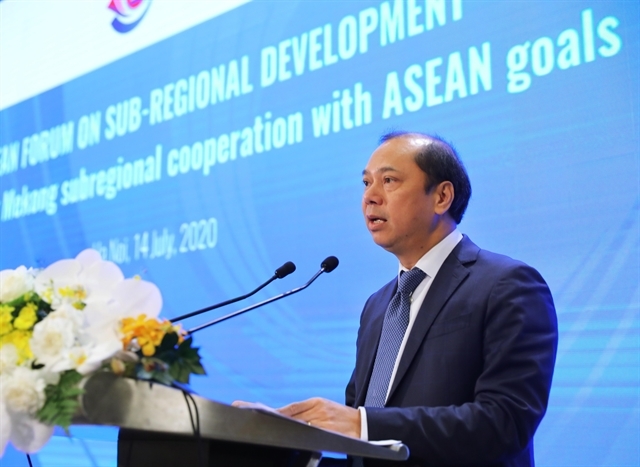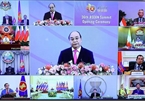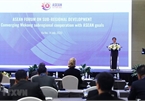 |
|
The development of a peaceful, prosperous and sustainable Mekong sub-region is indispensable to the success of ASEAN Community building, Vietnamese deputy minister of Foreign Affairs Nguyen Quoc Dung said.
|
He was speaking on Tuesday at a teleconference on converging Mekong sub-regional co-operation with ASEAN goals.
“The development of a peaceful, prosperous and sustainable Mekong sub-region is indispensable to the success of ASEAN Community building. The same holds true for other sub-regions in Southeast Asia,” he said.
"With growing markets and capable human resources, the Mekong sub-region is emerging as a favourable destination for investment and a key link of the global trade and manufacturing network," he said.
According to Minister of Industry and Trade Tran Tuan Anh, in terms of transport, development corridors under the sub-regional programmes such as Greater Mekong Sub-region and Mekong-Japan have contributed significantly to ASEAN transport connectivity and created an important foundation for ASEAN to begin expanding its links outside the region.
Some 10,000 km of road was built under the development of the three Mekong sub-regional economic corridors. In energy, ASEAN and its sub-regional partners share convergent goals and strategies in developing a reliable and secure supply of energy within the region, for example, the ASEAN Power Grid interconnections between Laos and Thailand are included in the Greater Mekong Sub-region pipeline of investment projects.
Dũng said as Mekong countries were navigating a fast-changing world to catch up with their ASEAN peers, they had contributed to ASEAN’s rise to the challenge of bridging development gaps within the region.
“The goal of narrowing development gaps within ASEAN and between ASEAN and the world has become more reachable thanks to the progress made by the CLMV countries in implementing ASEAN-wide targets.”
Dũng emphasised the need to ensure the catalytic role of ASEAN in the Mekong sub-regional development, saying sub-regional development should be closely aligned with ASEAN’s key documents that outline the organisation’s overall goals and direction, namely the ASEAN Community Vision 2025, Master Plan on ASEAN Connectivity 2025, and the Initiative for ASEAN Integration. In this context, ASEAN frameworks could serve as a basis for sub-regional initiatives while ASEAN structures, processes, and mechanisms could be used in the planning and implementation of such initiatives.
“It is no coincidence that the sub-region is becoming more geographically and strategically important given the rapid proliferation of numerous co-operation frameworks and initiatives with various stakeholders.
"ASEAN, therefore, needs to uphold its collective leadership in maintaining its central role in the evolving sub-regional architecture, and in forging and shaping the vision for closer and broader co-operation in the Indo-Pacific region,” he said.
Connectivity and sustainability
Speaking in Tokyo, Professor Fukunari Kimura, chief economist of Economic Research Institute for ASEAN and East Asia, said to achieve rapid, innovative, inclusive and sustainable economic growth, the Mekong sub-region should focus on four key areas – connectivity, industrialisation, human capital and sustainability.
“A path to pull up the whole Mekong sub-region to upper middle income will require substantial upgrading of industrial structure and the enhancement of people’s welfare,” he said.
Keiju Mitsuhashi, deputy country director, Viet Nam Resident Mission of Asian Development Bank (ADB), said there was increasing importance of physical to digital connectivity. In this post-COVID-19 period, digital connectivity is becoming more and more important to substitute and complement physical connectivity.
Since 1992, ADB and other donors have supported the co-operation of Greater Mekong Sub-region which comprises Cambodia, Laos, Myanmar, Thailand, Viet Nam and China’s Yunnan Province and Guangxi Zhuang Autonomous Region.
“We [ADB] have worked in three different layers, firstly, working directly within ASEAN, Greater Mekong Sub-region. Secondly, we have worked on cross-border projects in which two countries will be connected better. Thirdly, we have worked in-country projects. Each country will increase capacity to be connected with others,” he told media.
At a session on sustainable development, Caitlin Wiesen, UNDP Resident Representative in Viet Nam, shared several challenges in the Mekong River Basin due to fast socio-economic development exacerbated by climate change.
They include extreme droughts, forest fires, flash floods, heavy rains, rising sea levels, typhoons and saltwater intrusion.
She highlighted the great potential for increased renewable energy development in ASEAN countries including wind, solar, biomass and hydropower.
“If countries co-operate more closely and pursue a common framework of energy development that has an increase in renewable energy sources, this could lead to a reduction of the development of mega hydropower plants, which in turn will reduce severe environmental risks, especially to the Mekong region, while accelerating energy security for the ASEAN region,” she said. — VNS

COVID-19 - A test of ASEAN’s calibre
Southeast Asia was the first region in the world to be affected by COVID-19 due to its geographic proximity and close trade relations with China, where the outbreak began.

ASEAN forum on sub-regional development opens
ASEAN should prioritise the enhancement of connectivity, sustainable and inclusive development, and the improvement of its role in sub-region cooperation, including Mekong collaboration, Minister of Industry and Trade Tran Tuan Anh has said.